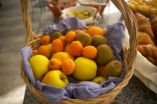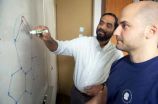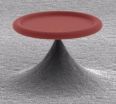(Press-News.org) For the first time, scientists have been able to "freeze in time" a mysterious process by which a critical enzyme metabolizes drugs and chemicals in food. By recreating this process in the lab, a team of researchers has solved a 40-year-old puzzle about changes in a family of enzymes produced by the liver that break down common drugs such as Tylenol, caffeine, and opiates, as well as nutrients in many foods. The breakthrough discovery may help future researchers develop a wide range of more efficient and less-expensive drugs, household products, and other chemicals. The scientists' findings will be published in the journal Science on 12 November 2010.
Michael Green, an associate professor of chemistry at Penn State University and lead author of the study, explained that scientists have speculated for decades that, during the process of metabolizing chemicals in the human liver, enzymes in the family named P450 pass through a critical chemical phase-change called "Compound I," whereby an oxygen molecule is temporarily added. However, until now, no one had actually seen the process happen or even had proven that it existed. "This phase change happens quickly, and P450 just as quickly changes back to its original state," Green explained. "So the challenge was trapping the enzyme at the exact moment that it went through the Compound I stage." First, Green and his colleagues grew one of the P450 enzymes in E.coli -- bacteria found in the human gut. They then developed a method to cool the enzyme at just the right rate -- one one-thousandth of a second -- to "freeze in time" the formation process of Compound I.
Green also explained that, while all humans have a gene responsible for making the P450 enzymes, different populations of humans vary in which version of the gene they carry, and thus, which version of P450 they produce. Such P450 variations lead to differences in the way people respond to particular drugs. "With a drug such as caffeine, for example, one population of people might be fast metabolizers, while another might metabolize the drug more slowly," Green explained. "Because the risk of caffeine-induced heart attack may be higher in slow metabolizers, the ability to actually take a snapshot of the phase changes of the P450 enzymes could help us to understand better how certain chemicals can affect people in vastly different ways."
Green's P40 research may also aid future scientific discoveries in the field of pharmacology. "Adverse drug-drug interactions are a well-known problem," Green explained. "The answer to why some people have bad interactions could be understood at the level of the P450 enzymes and their state changes. Now that we can see those state changes on a molecular level, a deeper investigation is finally possible."
INFORMATION:
Green's co-author is Jonathan Little, who was an undergraduate student in Penn State's Department of Chemistry throughout the research study. Little is now a graduate student at the California Institute of Technology.
This research was supported by a grant from the National Science Foundation.
CONTACTS
Michael Green: 814-863-0925, mtg10@psu.edu
Barbara Kennedy (PIO): 814-863-4682, science@psu.edu
IMAGES
High-resolution images related to this research are online at
http://www.science.psu.edu/news-and-events/2010-news/Green11-2010
Scientists demystify an enzyme responsible for drug and food metabolism
2010-11-12
ELSE PRESS RELEASES FROM THIS DATE:
Gene discovery suggests way to engineer fast-growing plants
2010-11-12
DURHAM, N.C. – Tinkering with a single gene may give perennial grasses more robust roots and speed up the timeline for creating biofuels, according to researchers at the Duke Institute for Genome Sciences & Policy (IGSP).
Perennial grasses, including switchgrass and miscanthus, are important biofuels crops and can be harvested repeatedly, just like lawn grass, said Philip Benfey, director of the IGSP Center for Systems Biology. But before that can happen, the root system needs time to get established.
"These biofuel crops usually can't be harvested until the second ...
Stanford scientists identify key protein controlling blood vessel growth into brains of mice
2010-11-12
STANFORD, Calif. — One protein single-handedly controls the growth of blood vessels into the developing brains of mice embryos, according to researchers at the Stanford University School of Medicine. Understanding how the protein, a cellular receptor, functions could help clinicians battle brain tumors and stroke by choking off or supplementing vital blood-vessel development, and may enhance the delivery of drugs across the blood-brain barrier.
"The strength and specificity of this receptor's effects indicate that it could be a very important target," said Calvin Kuo, ...
Fortify HIT contracts with education and ethics to protect patient safety, say informatics experts
2010-11-12
Bethesda, MD—An original and progressive report on health information technology (HIT) vendors, their customers and patients, published online today, makes ground-breaking recommendations for new practices that target the reduction or elimination of tensions that currently mar relationships between many HIT vendors and their customers, specifically with regard to indemnity and error management of HIT systems. In light of the Obama Administration's $19 billion investment in HIT, paid out in ARRA stimulus funds, these recommendations are particularly significant in helping ...
Graphene's strength lies in its defects
2010-11-12
PROVIDENCE, R.I. [Brown University] — The website of the Nobel Prize shows a cat resting in a graphene hammock. Although fictitious, the image captures the excitement around graphene, which, at one atom thick, is the among the thinnest and strongest materials ever produced.
A significant obstacle to realizing graphene's potential lies in creating a surface large enough to support a theoretical sleeping cat. For now, material scientists stitch individual graphene sheets together to create sheets that are large enough to investigate possible applications. Just as sewing ...
New analysis explains formation of bulge on far side of moon
2010-11-12
SANTA CRUZ, CA--A bulge of elevated topography on the farside of the moon--known as the lunar farside highlands--has defied explanation for decades. But a new study led by researchers at the University of California, Santa Cruz, shows that the highlands may be the result of tidal forces acting early in the moon's history when its solid outer crust floated on an ocean of liquid rock.
Ian Garrick-Bethell, an assistant professor of Earth and planetary sciences at UC Santa Cruz, found that the shape of the moon's bulge can be described by a surprisingly simple mathematical ...
Contact among age groups key to understanding whooping cough spread and control
2010-11-12
ANN ARBOR, Mich.---Strategies for preventing the spread of whooping cough---on the rise in the United States and several other countries in recent years---should take into account how often people in different age groups interact, research at the University of Michigan suggests.
The findings appear in the Nov. 12 issue of the journal Science.
Thanks to widespread childhood vaccination, whooping cough (pertussis) once seemed to be under control. But the illness, which in infants causes violent, gasping coughing spells, has made a comeback in some developed countries ...
Fruit flies lead scientists to new human pain gene
2010-11-12
Boston, Mass. - While it has become clear in recent years that susceptibility to pain has a strong inherited component, very little is known about actual "pain genes" and how they work. In the November 12th issue of Cell, researchers at Children's Hospital Boston and their collaborators report on a novel human pain gene. People with minor variations in this gene showed clear differences in susceptibility to acute heat pain and chronic back pain. Corroborating mouse studies give some clues as to how the gene controls pain sensitivity. The gene was uncovered in a genome-wide ...
All-optical transistor
2010-11-12
Controlling and modulating the flow of light is essential in today's telecommunications-based society. Professor Tobias Kippenberg and his team in EPFL's Laboratory of Photonics and Quantum Measurements have discovered a novel way to couple light and vibrations. Using this discovery, they built a device in which a beam of light traveling through an optical microresonator could be controlled by a second, stronger light beam. The device thus acts like an optical transistor, in which one light beam influences the intensity of another.
Their optical microresonator has two ...
Having severe acne may increase suicide risk
2010-11-12
Individuals who suffer from severe acne are at an increased risk of attempting suicide, according to a paper published on bmj.com today.
The study also finds that an additional risk may be present during and up to one year after treatment with isotretinoin, a commonly prescribed drug for severe acne. However, the authors stress that this additional risk is most likely due to the acne itself, rather than the drug treatment.
Isotretinoin (commonly marketed as Roaccutane, Accutane, Amnesteem, Claravis, Clarus or Decutan) has been used to treat severe acne since the 1980s. ...
Thousands of turtles captured in Madagascar despite ban
2010-11-12
New research has revealed up to 16,000 endangered turtles are being caught each year by villagers in just one region of Madagascar, despite a government ban.
Researchers from the University of Exeter and Blue Ventures Conservation say the figure, thought to be a conservative estimate, is the first direct assessment of turtle exploitation on the island.
The study highlights the extent of small-scale fishing, traditionally very difficult to monitor, and could be vital in finding a way to sustainably manage turtle fishing in the region.
Dr Annette Broderick, from the ...



